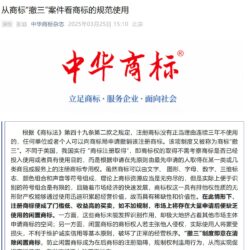In recent years, China has made significant strides in safeguarding the rights of trademark holders and fostering fair market competition by enhancing regulations against malicious trademark applications. The 2019 revision of the Trademark Law, along with the introduction of the Several Provisions on Regulating Trademark Application and Registration, has established a strong legal framework to effectively combat these detrimental applications. This has led to successful enforcement actions during the trademark authorization and confirmation processes.
It is essential to note that malicious trademark applications are not classified as trademark infringement. Therefore, the Trademark Law and its associated judicial interpretations do not impose civil liability in these cases. Instead, courts typically reference Article 2 of the Anti-Unfair Competition Law, which categorizes these malicious applications as acts of unfair competition. As a result, those found to be engaging in such practices may be required to cease their infringing activities, compensate for damages, and take measures to mitigate any negative impacts caused.
-
While they may not constitute trademark infringement, malicious applications can provide insight into the infringer’s degree of subjective fault.
In both the Castrol and Afton cases, the court provided important clarifications regarding trademark registration and infringement as outlined in Article 57 of the Trademark Law and its associated judicial interpretations. In the Castrol case, the court concluded that merely applying for trademark registration, without any actual use of the trademark in commercial activities, does not amount to trademark infringement. On the other hand, the Afton case highlighted that such an application could potentially violate existing rights and should be resolved through opposition, review, and judicial review procedures.
If a bad faith application does not meet the criteria for trademark infringement, the rights holder cannot directly seek civil liability against the applicant under Trademark Law. However, in instances of trademark infringement, evidence suggesting that the defendant has filed a bad faith application concerning the plaintiff’s registered trademark can be instrumental in demonstrating the defendant’s intent. This factor is crucial for the court when evaluating statutory damages and determining the appropriate compensation. For example, in the Hershey case, while the defendant’s repeated attempts to register a trademark similar to Hershey’s were not classified as infringing, both courts acknowledged that these actions reflected clear subjective malice. This behavior was considered when determining the defendant’s liability for trademark infringement.
-
Malicious Applications may Constitute Unfair Competition
In the BRITA and InSinkErator cases, courts have established that bad faith trademark applications can be considered acts of unfair competition. In the BRITA case, the court issued a significant ruling, determining that the squatter’s bad faith registration and misuse of trademark opposition procedures constituted unfair competition. Consequently, the defendant was required to compensate for damages and address the negative repercussions. Similarly, in the InSinkErator case, the court ordered the defendant to stop the preemptive registration of a trademark that was identical or similar to the disputed trademark. These rulings have opened new pathways for rights holders to effectively combat malicious trademark applications.
In the Beiersdorf case, the Tianjin Higher People’s Court also overturned the initial judgment at the end of 2023, concluding that malicious registration violated the principle of good faith and constituted an act of unfair competition as defined by the Anti-Unfair Competition Law.
According to recent case law, it is evident that courts have consistently recognized bad faith trademark applications as a type of unfair competition, as specified in Article 2 of the Anti-Unfair Competition Law. This provision comes into play when a business disrupts market competition and violates the legitimate rights and interests of other businesses or consumers, especially in cases where no other legal frameworks are applicable. Consequently, courts exercise caution when applying this article. In assessing whether a defendant’s actions constitute unfair competition, they take into account various factors, such as the distinctiveness and popularity of the trademark owned by the rights holder, the competitive relationship between the defendant and the rights holder, and other relevant criteria outlined in the Anti-Unfair Competition Law. Additionally, courts carefully examine the defendant’s intent and any possible malicious motives that may be present.
In this situation, the defendants demonstrate a notably high degree of subjective malice. Initially, they submitted trademark registration applications over an extended period—spanning several years—and in substantial numbers, often involving numerous trademarks that are either identical or closely resemble those of the rights holder. This conduct significantly surpasses what would typically be expected in standard business practices. Additionally, alongside their bad faith trademark applications, the defendants engaged in various infringement activities, including the actual use of these trademarks, misleading advertising, and the inappropriate use of administrative procedures. For instance, in the Bristin case, the defendant misused the opposition process, while in the Beiersdorf case, they were involved in counterfeiting the plaintiff’s business name and domain, among other deceptive actions.
In the case involving InSinkerator, while the defendant did not demonstrate bad faith in their continued use of the contested trademark, there is substantial evidence indicating a notable level of subjective malice. Specifically, several associated defendants have registered 48 trademarks that are either identical or similar to the plaintiff’s InSinkerator trademarks across various product categories over the past decade. Despite an administrative ruling that confirmed the defendant’s bad faith in trademark squatting, they persisted in their extensive squatting activities, suggesting an intention to exploit the goodwill of others and disrupt the trademark registration process.
China’s trademark system operates on a first-to-file principle, which requires commercial entities to apply for registration in order to secure their trademark rights. It is essential that these applications are reasonable and do not infringe upon the rights of others or seek to gain unfair advantages through the “trademark classification registration system.” Such practices can lead to confusion in trademark registration and disrupt market competition. Therefore, it is vital to address bad faith applications in accordance with the Anti-Unfair Competition Law.
According to established case law, courts may determine that a trademark application made in bad faith can be considered unfair competition under Article 2 of the Anti-Unfair Competition Law. However, it’s important to note that not every bad faith application will automatically meet this criterion. In some instances, the court will examine the applicant’s subjective intent, their objective actions, and the outcomes of their conduct. For example, in the Castrol case, the court concluded that merely applying for trademark registration did not constitute “production and operation,” thereby excluding it from the Anti-Unfair Competition Law’s purview. Consequently, rights holders should thoughtfully assess whether they can pursue protection under this law, taking into account the unique circumstances of their case.
-
Liability for Malicious Application in Infringement
When a malicious application is identified as engaging in unfair competition, the offending party is typically obligated to cease the infringement, provide compensation for any damages incurred, and take measures to mitigate any adverse effects. In cases involving statutory damages, courts often support the plaintiff’s claims for direct economic losses resulting from the defendant’s malicious trademark squatting. In the Beiersdorf case, the court highlighted that factors influencing statutory damages should include the “unnecessary costs of rights protection” that the plaintiff incurred over an extended period while defending her rights against the defendant’s ongoing trademark squatting.
There are varying opinions among courts regarding the enforcement of cessation of infringement liability. In the InSinkErator case, the court determined that while a formal judgment to stop the infringement is not strictly necessary, the minimal costs associated with trademark squatting require the rights holder to actively protect their legitimate rights and interests. Failing to do so could lead to increased costs for rights protection and a misuse of public resources, prompting the court to direct the defendant to cease their preemptive registration. Similar conclusions have been reached in other pertinent cases.
In the Beiersdorf case, the court ruled that the defendant’s trademark registration application was considered complete upon submission. This decision indicated that there was no factual basis to halt the trademark squatting. These two cases illustrate the differing interpretations by the courts regarding whether the cessation of infringement applies to potential infringements. According to the Understanding and Application of Tort Liability in the Civil Code of the People’s Republic of China, the requirement for cessation of infringement stipulates that the infringement or other illegal activities must be ongoing or continuous; it does not cover infringements that have not yet occurred or those that have already ended. Therefore, based on this interpretation, it appears inappropriate to apply the cessation of infringement to a trademark filed in bad faith.
-
Summary
In summary, the court’s established precedent regarding bad faith trademark applications highlights the crucial role that opposition and invalidation efforts by rights holders play in the trademark authorization and confirmation process within civil litigation. It is vital for rights holders to take proactive measures against malicious applications during the administrative phase to prevent these actions from becoming entrenched. Additionally, there are varying interpretations of Article 2 of the Anti-Unfair Competition Law concerning the regulation of bad faith trademark registrations. To effectively address this matter, it is important to develop or amend relevant legislation to clearly define the nature of the infringement and the associated liabilities for bad faith applications. This approach will strengthen efforts to combat such registrations, uphold the integrity of trademark registration, protect the legitimate rights of rights holders, and promote a fair competitive market environment.


